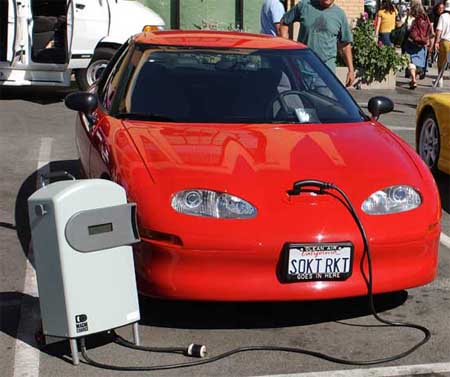
According to a study sponsored by the American Lung Association of California, $142 billion in human health and global warming reduction benefits would result from converting the entire California motor vehicle fleet from gasoline vehicles to zero-emission vehicle (ZEV) technologies in the 2010-2030 time frame, or $96 billion more than relying on the lowest emitting gasoline technologies. The $142 billion figure includes $38 billion in benefits to society from reduced global warming emissions.
The study, conducted by TIAX LLC, a consulting firm specializing in transportation and alternative fuels research, also found that California can avoid at least $2.2 billion per year in health costs from reduction of dangerous particulate matter by converting the motor vehicle fleet to ZEVs instead of relying on the lowest emitting gasoline technologies. This reduction in particulates means that California would annually avoid 300 cases of premature death, over 260 cases of chronic bronchitis, over 7,000 asthma attacks and more than 18,000 cases of upper and lower respiratory symptoms by moving to ZEV technology.
“Maintaining our momentum toward cleaner cars will save billions in health costs, and save lives,” said Tony Gerber, MD, an American Lung association of California volunteer. “Now is not the time for the California Air Resources Board (ARB) to weaken the state’s key program that leads to cleaner vehicle technology, and cleaner air.” Dr. Gerber is a pulmonary specialist and assistant professor at the University of California, San Francisco.
American Lung Association of California Senior Policy Director Bonnie Holmes-Gen will testify on the results of the study when the ARB holds a hearing on Thursday, March 27 to consider amendments to its signature ZEV program. The California Air Resources Board (ARB) staff proposal would reduce the “pure ZEV” or “gold standard” program requirement from 25,000 to 2,500 vehicles in the 2012-2014 time frame. The American Lung Association of California will be urging the ARB Board to reject the low volumes of “pure ZEVs” and plug-in hybrids recommended in the staff proposal.
“The Air Resources Board is at a critical juncture right now,” said Holmes-Gen. “The Board has a tremendous opportunity to set a bold new vision for the ZEV program that includes strengthening the program to fully support the state’s goals for both healthy air and global warming reduction.”
She added, “The American Lung Association analysis provides a stark comparison of California’s future transportation choices: pursuing the existing pathway of primarily gasoline vehicles or pursuing a dramatic change to widespread use of electric technology. Given the pressing need to achieve the state’s global warming pollution reduction targets, the ARB should expand the ZEV program and establish a goal of integrating electric-drive technology in all new vehicles as soon as possible.” The American Lung Association is urging ARB to both establish aggressive goals for introducing pure ZEVs into the vehicle fleet and pursuing much broader requirements for utilization of electric drive technologies, including conventional hybrids and plug-in hybrids in addition to hydrogen fuel cell and full function battery electric vehicles.
According to the American Lung Association of California’s study, approximately 110 million tons of greenhouse gases per year could be avoided if all California vehicles were replaced with ZEVs by 2030. This would make significant progress toward the transportation sector’s portion of the state goal for reducing greenhouse gases by 2050.
The study also addressed the current costs of gasoline motor vehicle use:
— The total cost to public health and society of the existing motor vehicle fleet is over $10 billion in 2010, and this cost only drops to approximately $7 billion over the 20-year time frame of the study with normal fleet turnover.
— The existing motor vehicle fleet generates health costs in terms of hospitalizations, premature deaths and illnesses that add up to over $7.4 billion per year (2010), including $4.4 billion per year linked to one pollutant, nitrogen oxide (NOx).
— The total greenhouse gas (well-to-wheel) emissions from the existing motor vehicle fleet are 150 million tons per year, and drop only to 140 million tons per year in 2030 through existing programs and vehicle turnover. This is far from the total reduction that is needed to meet California’s greenhouse gas reduction goals.
“ZEVs are the road to healthier air and a sustainable transportation future,” said Holmes-Gen, “and the American Lung Association of California is looking to the California Air Resources Board to make the vision of zero pollution transportation a reality.”
Yes it’s pretty much true once weds move towards EV’s, there would be more greenery !
ZAP and alike have shown us the way.
I am glad that motor vehicle fleet is taking steps toward a cleaner, more healthy environment. I only hope that it continues. All forms of vehicles need to be address i.e. airplanes buses, jetliners, rockets, etc. Do you see were I am going with this? Converting cars to electric is only scratching the surface to a cleaner environment. More has to be done.
electric cars are stupid